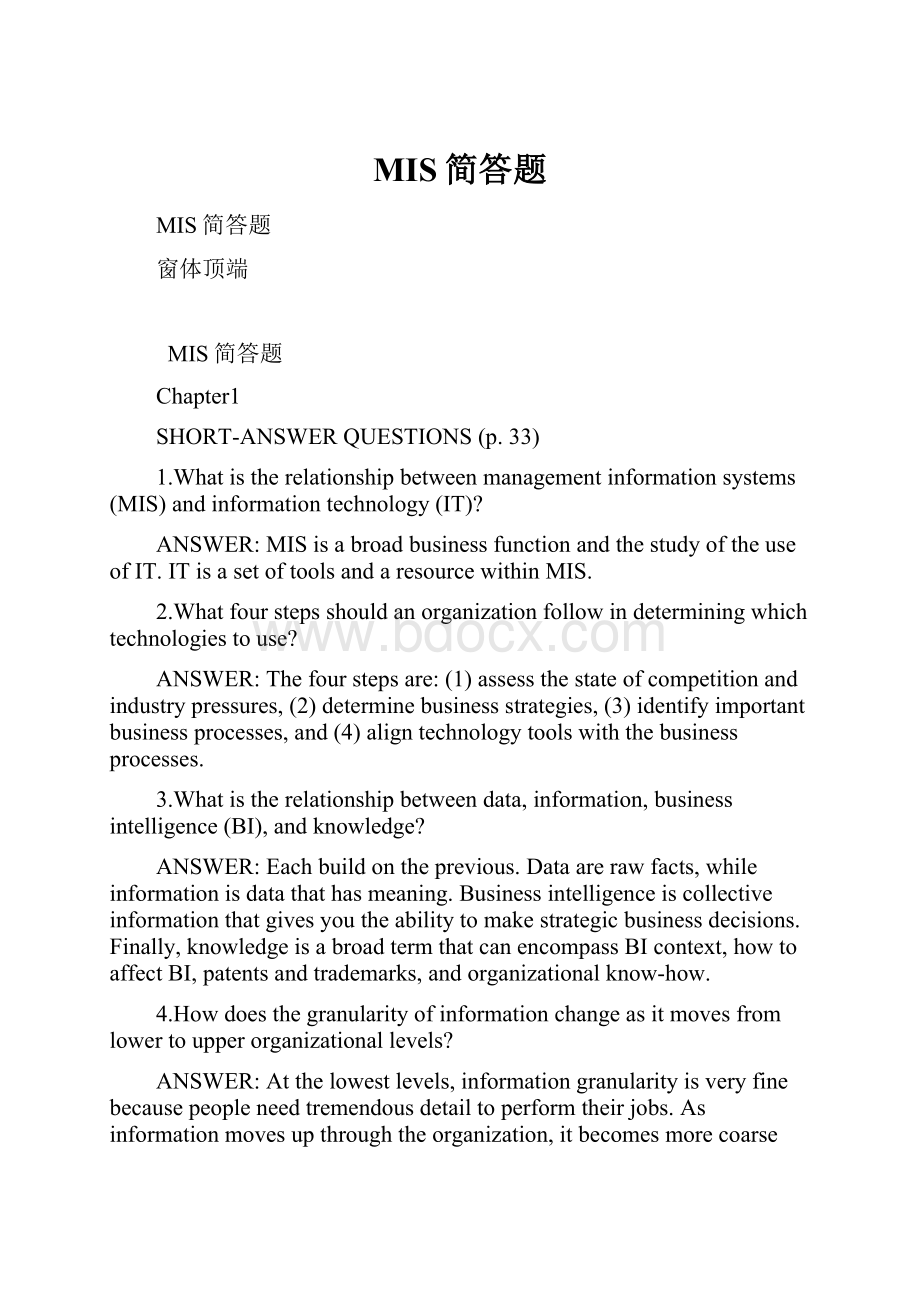MIS简答题Word文件下载.docx
《MIS简答题Word文件下载.docx》由会员分享,可在线阅读,更多相关《MIS简答题Word文件下载.docx(13页珍藏版)》请在冰豆网上搜索。

2.Whatfourstepsshouldanorganizationfollowindeterminingwhichtechnologiestouse?
Thefourstepsare:
(1)assessthestateofcompetitionandindustrypressures,
(2)determinebusinessstrategies,(3)identifyimportantbusinessprocesses,and(4)aligntechnologytoolswiththebusinessprocesses.
3.Whatistherelationshipbetweendata,information,businessintelligence(BI),andknowledge?
Eachbuildontheprevious.Dataarerawfacts,whileinformationisdatathathasmeaning.Businessintelligenceiscollectiveinformationthatgivesyoutheabilitytomakestrategicbusinessdecisions.Finally,knowledgeisabroadtermthatcanencompassBIcontext,howtoaffectBI,patentsandtrademarks,andorganizationalknow-how.
4.Howdoesthegranularityofinformationchangeasitmovesfromlowertoupperorganizationallevels?
Atthelowestlevels,informationgranularityisveryfinebecausepeopleneedtremendousdetailtoperformtheirjobs.Asinformationmovesupthroughtheorganization,itbecomesmorecoarsebecausepeopledon’tneedasmuchdetailbutratheraggregationsofinformation.
5.Whatisthedifferencebetweenatechnology-literateknowledgeworkerandaninformation-literateknowledgeworker?
Atechnology-literateknowledgeworkerknowshowandwhentoapplytechnology;
thatis,he/sheunderstandsthevalueandroleoftechnology.Aninformation-literateknowledgeworkerknowsallaboutinformation;
thatis,he/sheunderstandsthevalueandroleofinformation.
6.Howdoethicsdifferfromlaws?
Lawseitherclearlyrequireorprohibitanaction.Ethicsaremoresubjective,moreamatterofpersonalorculturalinterpretation.
7.WhatroledoestheFiveForcesModelplay?
Porter’sFiveForcesModelhelpsbusinesspeopleunderstandtherelativeattractivenessofanindustryandtheindustry’scompetitivepressuresintermsofbuyerpower,supplierpower,threatofsubstituteproductsorservices,threatofnewentrants,andrivalryamongexistingcompetitors.
8.Whyarecompetitiveadvantagesneverpermanent?
Onceanorganizationcreatesacompetitiveadvantage,allcompetitorsmovetooffersimilarorevenbettercompetitiveadvantages,thusnullifyingthecompetitiveadvantageofthefirstorganization.
9.WhatarethethreegenericstrategiesaccordingtoMichaelPorter?
ThethreegenericstrategiesaccordingtoMichaelPorterare:
overallcostleadership,differentiation,andfocus.
10.HowarePorter’sthreegenericstrategies,anabove-the-lineversusabelow-the-lineapproach,andtheRGTframeworksimilar?
Theyaresimilarasfollows:
(1)run=overallcostleadership=bottomline,
(2)grow=focusanddifferentiation=topline,and(3)transform=(new)differentiation=topline(whenthefocusisinnovation).
11.Whatistheroleofvalue-chainanalysis?
Value-chainanalysisisasystematicapproachtoassessingandimprovingthevalueofbusinessprocesseswithinyourorganizationtofurtherincreaseitcompetitivestrengths.So,value-chainanalysishelpsyouidentifyimportantbusinessprocessesandhowtechnologymighthelpsupportthem.
Chapter2
SHORT-ANSWERQUESTIONS(p.59)
1.Whyisthetraditionalbuy-hold-sellinventorymodelanexpensiveandpotentiallyriskyone?
Thetraditionalinventorymodelrequiresthat
(1)youcreateinventorywithoutaknowndemand,
(2)youkeepalotofinventorythroughoutthesupplychain,and(3)youselloffobsoleteinventoryataverylowprice.
2.Whatistheroleofasupplychainmanagement(SCM)system?
Theroleofasupplychainmanagement(SCM)systemistosupportsupplychainmanagementactivitiesbyautomatingthetrackingofinventoryandinformationamongbusinessprocessesandacrosscompanies.
3.HowdoesSCMfitintoPorter’sthreegenericstrategies?
SCMismostcommonlyassociatedwiththeoverallcostleadershipgenericstrategy.
4.WhatarethetypicalfunctionsinaCRMsystem?
ThetypicalfunctionsinaCRMsystemincludesalesforceautomation,customerserviceandsupport,andmarketingcampaignmanagementandanalysis.
5.HowdoesCRMfitintotheRGTframework?
CRMismostcommonlyassociatedwithgrowingtheorganizationintheRGTframework.
6.Whatisthedifferencebetweenfrontofficeandbackofficesystems?
Afrontofficesystemistheprimaryinterfacetoacustomerandasaleschannel,whileabackofficesystemisusedtofulfillandsupportcustomerorders.
7.Forwhatfivethingsdoese-collaborationprovidesupport?
E-collaborationsupports
(1)workactivitieswithinintegratedcollaborationenvironments,
(2)knowledgemanagementwithknowledgemanagementsystems,(3)socialnetworkingwithsocialnetworkingsystems,(4)learningwithe-learningtools,and(5)informalcollaborationtosupportopen-sourceinformation.
8.Whatisthedifferencebetweenasocialnetworkingsiteandasocialnetworkingsystem?
Asocialnetworkingsite(e.g.,Myspace)isasiteonwhichyoupostinformationaboutyourself,createanetworkoffriends,sharecontent,andsoon.AsocialnetworkingsystemisanITsystemthatlinksyoutopeopleyouknowand,fromthere,topeopleyourcontactsknow.
9.Whatisopen-sourceinformation?
Open-sourceinformationiscontentthatispubliclyavailable(inabroadsense),freeofcharge,andmostoftenupdateablebyanyone.
10.WhatarethethreemostcommonwaysinwhichtheITfunctioncanbeplacedwithinanorganization?
ThethreemostcommonwaysinwhichtheITfunctionscanbeplacedare:
top-downsilo,matrix,andfullyintegrated.
11.HowarethestructuringoftheITfunctionandthephilosophicalapproachtoITinterrelated?
Theyareinterrelatedinthatthephilosophicalapproachismostoftenimplementedasaspecificstructure.Wait-and-seeorganizationstendtocentralizetheITfunctioninatop-downsiloapproach,whileearlyITadopterstendtodispersetheITfunction(i.e.,eithermatrixorfullyintegrated).
12.Whatisanenterpriseresourceplanning(ERP)system?
AnERPsystemisacollectionofintegratedsoftwareforbusinessmanagement,accounting,finance,HR,projectandinventorymanagement,supplychain,customerrelationshipmanagement,e-collaboration,etc.
Chapter3
SHORT-ANSWERQUESTIONS(p.90)
1.Whatisbusinessintelligence?
Whyitismorethanjustinformation?
Businessintelligenceisknowledge–knowledgeaboutyourcustomers,yourcompetitors,yourpartners,yourcompetitiveenvironment,andyourowninternaloperations.Itismorethanjustinformationbecauseitcombinesvarioustypesofinformationtoallowyoutomakebetterdecisionsandoperatemoreproductively.
2.Whatisonlinetransactionprocessing(OLTP)?
OLTPisthegatheringofinputinformation,processingthatinformation,andupdatingexistinginformationtoreflectthegatheredandprocessedinformation.
3.Whatisonlineanalyticalprocessing(OLAP)?
Onlineanalyticalprocessing(OLAP)isthemanipulationofinformationtosupportdecisionmaking.ItdiffersfromOLTPinthatitdoesnotprocesstransactionsbutrathermanipulatesexistinginformationtosupportthemakingofadecision.
4.Whatisthemostpopulardatabasemodel?
Themostpopulardatabasemodelistherelationaldatabasemodel.
5.Howareprimaryandforeignkeysdifferent?
Aprimarykeyisafieldthatuniquelyidentifiesarecordinarelationofadatabasewhileaforeignkeyisaprimarykeyofonefilethatappearsinanotherfile.So,primarykeysmustbeuniqueinagivenrelationwhileforeignkeysdonothavetobe.Theyarethesameinthatbothareusedtoenforceintegrityconstraints.
6.Whatarethefivesoftwarecomponentsofadatabasemanagementsystem?
ThefiveimportantsoftwarecomponentsofaDBMSare
(1)DBMSengine,
(2)datadefinitionsubsystem,(3)datamanipulationsubsystem,(4)applicationgenerationsubsystem,and(5)dataadministrationsubsystem.
7.HowareQBEtoolsandSQLsimilar?
Howaretheydifferent?
QBEtoolsandSQLaresimilarinthattheybothgiveyoutheabilitytocreatequeriestofindinformationinadatabase.TheyaredifferentinthatQBEtoolsprovideaGUIinterfacewhileSQLrequiresthatyoucreateyourqueryinstatementform.
8.Whatisadatawarehouse?
Howdoesitdifferfromadatabase?
Thefourtypesofinformationaccordingtowhatinformationdescribesareinternal,external,objective,andsubjective.
9.Whatarethefourmajortypesofdata-miningtools?
Thefourmajortypesofdataminingtoolsareintelligentagents,query-and-reportingtools,multidimensionalanalysistools,andstatisticaltools.
10.Whatisadatamart?
Howisitsimilartoadatawarehouse?
Adatamartisasubsetofadatawarehouseinwhichonlyafocusedportionofthedatawarehousedinformationiskept.
Chapter4
SHORT-ANSWERQUESTIONS(p.123)
11.Whatarethefourtypesofdecisiondiscussedinthischapter?
Giveanexampleofeach.
Nonrecurring,oradhoc,decisionisonethatyoumakeinfrequently(perhapsonlyonce)andyoumayevenhavedifferentcriteriafordeterminingthebestsolutioneachtime.Amergerwithanothercompanyisanexample.Recurringdecisionsaredecisionsthatyouhavetomakerepeatedlyandoftenperiodically,whetherweekly,monthly,quarterly,oryearly.Anexamplewouldbewhichroutetot